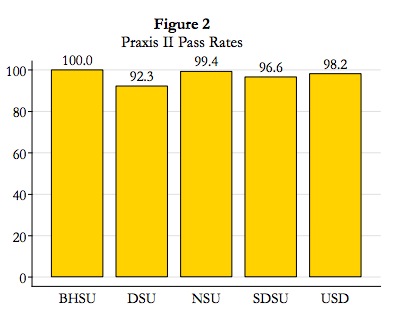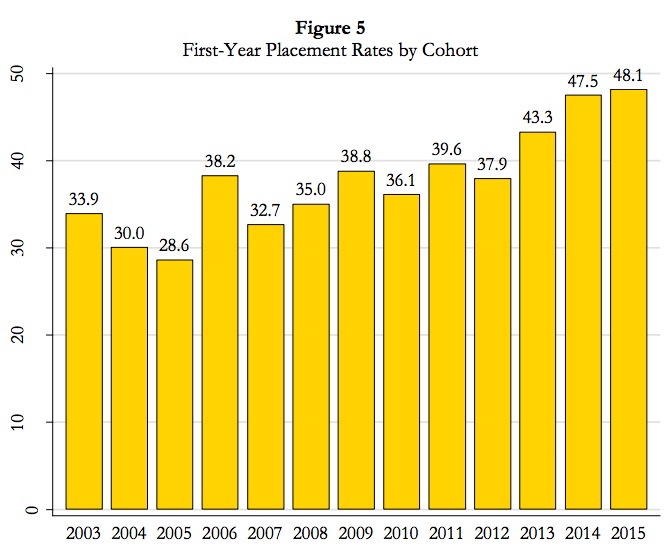Yesterday I reported that Black Hills State University and Northern State University have the lowest rates of students in good academic standing in the South Dakota Regental system. Interestingly, their undergraduate teacher candidates may be the smartest in the state:

According the the South Dakota Board of Regents, every teacher candidate at Black Hills State in the 2014–2015 school year passed the Praxis II test required for teacher certification. Northern’s teacher candidates were a close second with a 99.4% pass rate. USD still beat SDSU (aarrgghh! get on the ball, Jackrabbits!), while DSU had the lowest pass rate (too much note-taking on those darn computers, I’ll bet!).
Interestingly, the number of teacher graduates from our public universities in 2014 was the highest since 2002:

USD’s teacher program grew at recession time. BHSU’s teacher program declined at recession time, then bounced back higher than 2002. SDSU was surging a bit but had an off year in 2014, dropping back to 2002 levels. NSU and DSU both saw teacher graduate numbers decline when the recession hit and returned to only two-thirds of their 2002 levels.
Another instructive chart shows the flip side of the teacher shortage that this year’s new K-12 teacher pay funding is supposed address: more first-year teachers have been landing classroom gigs in South Dakota right out of the university gates:

In 2005, fewer than three in ten new teacher graduates were granted the honor of educating our youth. In 2015, that number was closer to five in ten. That increase could reflect increasing awesomenimnity of new teacher graduates, but more likely it reflects more demand and less supply (more veteran teachers retiring, less competition for openings).
We should watch all three of these charts to see if the pay raises funded by the 2016 Legislature change these numbers. If the teacher pay plan works as expected, we should see the teacher graduate data rise—more young people reaching for the not-as-humiliatingly small money in teaching. If we see more students enter the field, Praxis test scores may dip in response to a wider range of applicants or possibly rise at DSU and SDSU, reflecting higher pay drawing more talent. One would think that higher teacher pay would cause the first-year placement numbers to slide down again, but the teacher retirement bubble could keep those numbers steady regardless of the pay situation, at least for a few years.
As you stated Cory, I would think that the increase in first year placements rates has to do with the increasing turn-over rates in the teaching profession. Teachers have been leaving the profession in higher numbers and these openings have to be filled by more first year teachers. Thus, it is a reminder that education funding will continue to be of utmost importance in terms of prioritization of our resources.